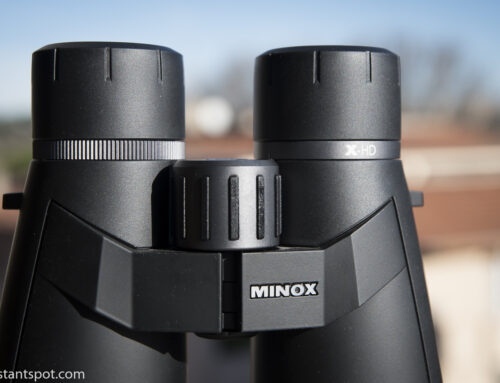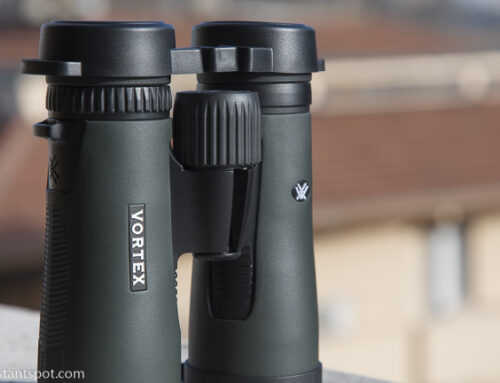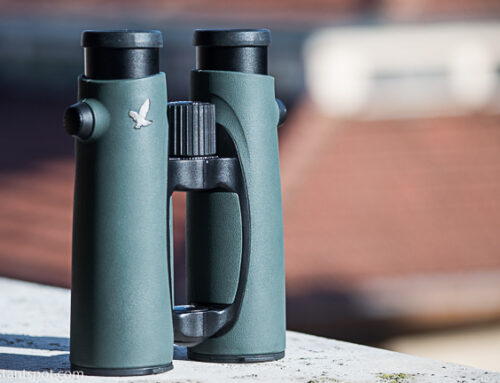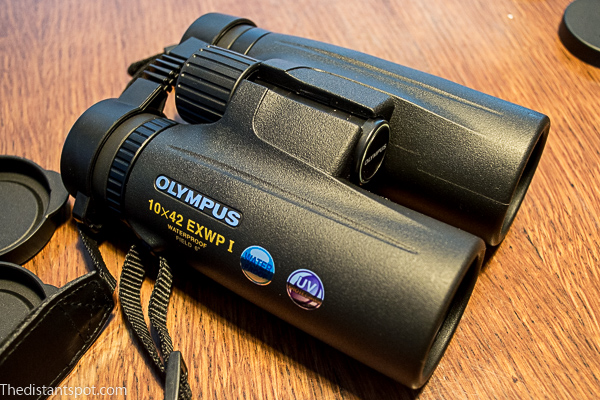Olympus EXWP I 10×42
The first thing to point out is that, while the production was originally done in Japan, it moved to China in more recent years.
In May 2014 I paid 380€ for them.
The chromatic aberration is quite evident, although not too annoying. It is visible as a colored outline already not far from the center of the image. The sharpness is good, but the objects framed do not appear engraved as in other binoculars, to which the Olympus EXWP I 10×42 show that veiling effect that is typical of a poorly contrasted image. The colors are not particularly bright, but they seem correct.
The real field of view amounts to 6 degrees with an apparent diameter of 60 degrees, so the image provided is wide and pleasant.
The point of maximum sharpness extends throughout the central portion of the image and the quality begins to deteriorate only towards 70% of the image, but in a very gradual manner. The extreme edge is hardly exploitable, but does not disturb the vision. This is a great advantage compared to some birdwatching binoculars that are perfect only at the exact center of the image and become awful as you move towards the border.
Unfortunately they greatly suffer from stray light and show a lot of reflexes even when the light source is at various degrees of distance on the side. Aiming at a lamppost, the diffraction generates an obvious X that extends from the upper edge to the lower edge of the image. This effect, however, does not seem to affect celestial observation, in which the luminous intensities involved are lower. Vega appeared normal and so did Saturn. The Moon appears to be surrounded by a very strong luminous halo, even though, since it is such an extended object, the effect is not very evident.
The visible image appears uniformly illuminated and the edge is a very sharp black circle (I love it!).
They are balanced binoculars, which do everything well without excelling in anything. At the same time, they do not have any major defect (chromatic aberration is probably their weakest point).
Since binoculars are always a matter of compromise (unless you want to spend VERY high figures to reach absolute – or almost absolute – perfection) the Olympus EXWP I 10×42 represent an excellent middle ground.
One last aspect, not strictly optical but still important: they are supplied in a very adherent neoprene case, which protects them while reducing their footprint, so that, once stored, they become almost smaller than my Nikon Prostaff 7S 8×30, which instead come in a hard case that is decidedly disproportionate for their size (feel free to go check their review). It is a great added value when you want to carry them around.
Finally, keep in mind that ten magnifications (10x) can annoy those who do not have an exceptionally firm hand: they are good for quick glances and for scouting a panorama, but can be excessive for astronomical freehand observation, where you tend to focus on that distant spot (:-)) for a while triyng to grasp all the minor details.
With two filters on the tubes, I used them to watch the 2017 solar eclipse. I studied the sunspots (I think there were three) while waiting for totality and then I removed the filters and just watched the sun. It was an unbelievable vision and I feel that 10x magnification was the correct choice for the occasion: it felt like being there ON the sun, except for the heat ;-)
The rainguard that covers the eyepieces broke after five years of mild use. It broke in the middle, so it is still usable.
Olympus EXWP I 10×42
The first thing to point out is that, while the production was originally done in Japan, it moved to China in more recent years.
In May 2014 I paid 380€ for them.
The chromatic aberration is quite evident, although not too annoying. It is visible as a colored outline already not far from the center of the image. The sharpness is good, but the objects framed do not appear engraved as in other binoculars, to which the Olympus EXWP I 10×42 show that veiling effect that is typical of a poorly contrasted image. The colors are not particularly bright, but they seem correct.
The real field of view amounts to 6 degrees with an apparent diameter of 60 degrees, so the image provided is wide and pleasant.
The point of maximum sharpness extends throughout the central portion of the image and the quality begins to deteriorate only towards 70% of the image, but in a very gradual manner. The extreme edge is hardly exploitable, but does not disturb the vision. This is a great advantage compared to some birdwatching binoculars that are perfect only at the exact center of the image and become awful as you move towards the border.
Unfortunately they greatly suffer from stray light and show a lot of reflexes even when the light source is at various degrees of distance on the side. Aiming at a lamppost, the diffraction generates an obvious X that extends from the upper edge to the lower edge of the image. This effect, however, does not seem to affect celestial observation, in which the luminous intensities involved are lower. Vega appeared normal and so did Saturn. The Moon appears to be surrounded by a very strong luminous halo, even though, since it is such an extended object, the effect is not very evident.
The visible image appears uniformly illuminated and the edge is a very sharp black circle (I love it!).
They are balanced binoculars, which do everything well without excelling in anything. At the same time, they do not have any major defect (chromatic aberration is probably their weakest point).
Since binoculars are always a matter of compromise (unless you want to spend VERY high figures to reach absolute – or almost absolute – perfection) the Olympus EXWP I 10×42 represent an excellent middle ground.
One last aspect, not strictly optical but still important: they are supplied in a very adherent neoprene case, which protects them while reducing their footprint, so that, once stored, they become almost smaller than my Nikon Prostaff 7S 8×30, which instead come in a hard case that is decidedly disproportionate for their size (feel free to go check their review). It is a great added value when you want to carry them around.
Finally, keep in mind that ten magnifications (10x) can annoy those who do not have an exceptionally firm hand: they are good for quick glances and for scouting a panorama, but can be excessive for astronomical freehand observation, where you tend to focus on that distant spot (:-)) for a while triyng to grasp all the minor details.
With two filters on the tubes, I used them to watch the 2017 solar eclipse. I studied the sunspots (I think there were three) while waiting for totality and then I removed the filters and just watched the sun. It was an unbelievable vision and I feel that 10x magnification was the correct choice for the occasion: it felt like being there ON the sun, except for the heat ;-)
The rainguard that covers the eyepieces broke after five years of mild use. It broke in the middle, so it is still usable.





